Archive for category Writing
Some Brief Words on Penn Zero: Part-Time Hero
Posted by kjohnson1585 in Animation, Television, Uncategorized, Writing on July 28, 2017
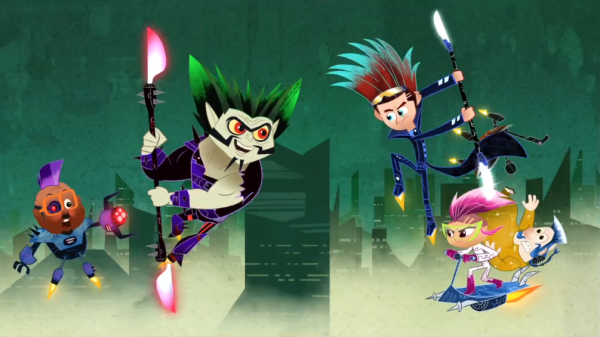
The premise of Penn Zero: Part-Time Hero doesn’t make any sense. A boy and his friends, who all still attend school, head into an abandoned theater where they are warped into alternate dimensions, take the role of some kind of protagonist/leader (and their sidekicks/lackeys), and have to accomplish some grand objective. When they do this, they (apparently?) take over the bodies of characters that already exist in that world. They also have to face a set of antagonists/villains that are controlled/taken over by their art teacher and school principal. When they return home, everything is back to the way things are – as normal as things could be. There’s a lot of questions. How did a bunch of kids get into the gig of interdimensional body-control and part-time heroics? (Penn, arguably, got into it through his parents – more on this later – but his sidekicks Sashi and Boone are occupational enigmas.) What happens to the people when they take over their bodies? What about Rippen and Larry? Who is Phyllis, the lady who controls the portal machine? What signals a particular world that needs heroics? Why would a world need competing villains? How long has all this been going on? And why?
I think that most of these questions were meant to be answered – or least explored – over the course of several seasons. It only received two. And as Penn Zero ends its two season run today, we’re given all the answers we’ll ever get (bearing an unlikely comic or graphic novel followup). In a way, it’s fine. The second season of Penn Zero did little about answering those big questions, and focused on smaller, personal bits of characterization – and exaggerated cartoon satire in the midst of broad, insanely creative alternate dimensions. The show scrambled together a brief, clearly-rushed season arc in which Penn had to find some crystal shards so Phyllis can track where his parents are (also part-time heroes), an arc that gets its due only in four of the final fourteen episodes. It spent most of its other episodes either revisiting past worlds with new, more intense objectives, or finding themselves in new locales with more ridiculous, almost nonsensical ones. Penn Zero, in its remaining season, culled together final episode pitches with an assortment of ideas that seem geared for a multiple seasons. It treated its second season as if it was its fifth season.
There’s something bold about that, though. I mean, if you’re forced to end your show a bit prematurely, you might as well throw all your best ideas out there. It may be too many ideas though. Episodes feel overrun at times, like Penn’s return to a world of dragons that, in the first season, just doubled as a Top Gun parody. The team’s second appearance incorporate elements from Star Wars, Aliens, My Little Pony, and a host of other pop culture references that I recognized. There’s also a lot of wink-winking towards animation tropes, like a hilarious anime-parody episode, a sitcom-bashing one, and one that engaged in a classic cat-and-mouse chase cartoon, similar to Tom & Jerry. Some episodes are just plan weird: the cast returns to a world where everyone is some kind of sport ball, literally, and it includes Curtis Armstrong as a super bouncy ball with serious insecurity and anger issues for some reason. An episode that checks in on Penn’s parents includes a fire-breathing giant chicken, a sketchy city inside the belly of said chicken, a sleazy pickpocket with an eyeball for a belly and lips for a head (voiced my Marc Maron), and mafioso, flamethrower-wielding grandmother with zombie cat demons for henchmen. This… is a weird show.
Speaking of which, the situation with Penn’s parents form the backbone of the show’s arc. They’re trapped in that bizarre world mentioned in the previous paragraph, and Penn has to recover three shards of… something to bring them back. It’s not exactly a tightly-scripted story arc – the retrieval of the first shard is accomplished during a weird random end tag, involving a giant Phyllis, which raises even more questions (and I know I’m skipping a lot of explanation here, but the episode has Penn deciding whether to go after the shard or save the day, and it doesn’t explain why Penn doesn’t just go after the shard after saving the day, or coming back to this world just a bit later). It does however delineate high-level stakes to these final episodes. There is pretty strong theme of loyalty, heroics, and sacrifice, especially between the roles of parental and childish figures, but fourteen episodes are not nearly enough to delve into them. Still, Penn Zero went ahead and did it anyway, which requires some balls.
You can’t help but wonder if Penn Zero: Part-Time Hero was meant to be the popular followup to Phineas and Ferb, another show that involved a weird-looking red-haired kid and random forays into strange places (that now looks to be Milo Murphy’s Law, a show that needs to explored at another time). Disney XD was going through some issues, and a lot of two season shows got shut down (including the delightful Wander Over Yonder and the not-so-delightful 7D). I don’t know if Penn Zero needed, or deserved, more time to flesh itself out. It was funny and clever enough, the characters were perfectly, comically realized (Sashi (Tani Guadi) was the overall show standout but second-season Penn (Thomas Middleditch) came up strong), and it clearly had a blast coming up with some of the alternate dimensions and the plots that took place in them. It felt like it got so caught up in that creative freeform that it never took the time it needed to really let its characters, and its specific in-world logic, explain itself.
That’s not necessarily bad. Lots of shows don’t make sense and thrive on that concept: Archer is purposely anachronistic, and Phineas and Ferb enjoyed its creative freedom. The latter show also knew to keep its central concept basic – a couple of kids just trying to find something to do during summer vacation – so when things did get crazy, it could count on cartoon logic to carry it through. Penn Zero often relies on cartoon logic as well – with plenty of self-aware, forth-wall gags, like when a Penn-as-kaiju destroys a “Rule of Thirds” Store on his third accidental stomp – but it’s too ingrained into its emotionally-charged backstory to escape from it. What happens if a hero fails – or worse, dies? That threat looms over the show, if never taken seriously whatsoever. Still, it’s possible, and I almost feel like the show would have been better off ditching any semblance of a season arc all together.
Still, Penn Zero: Part-Time Hero is just weird enough, funny enough, and creative enough to check out its final run, and its assortment of solid guest starts is also wildly impressive, which includes Mar Maron, Mark Hamill, Maria Bamford, Kumail Nanjiani, and Yvette Nicole Brown. Mercury Filmworks and Disney Television Animation pushes the paper-like-cutout designs in some striking ways within the animation, both large and small: large-scale, sweeping movements are as grandiose as some small, detailed facial expressions are hilarious. Penn Zero is a fun lark, and it’s somewhat sad to see it go “before its time,” but in some ways, it’s for the best. There’s too much going on that shouldn’t really be going on, and it’s better to end it before it reaches fan-theory status.
FINAL THOUGHTS ABOUT THE FINALE: If anything, “At the End of the Worlds” confirms the idea that Penn Zero: Part-Time Hero is probably better off ending now instead of continuing, even despite the fact it thrived with potential. It committed to a weirdness that felt more egregious than necessary or clever, and I’m not exactly talking about the revelation that Phil and Phyllis were separate entities of some kind of intergalactic time-space being gloriously entering Phase Two of some cosmic mission (I swear this is all true). You could argue, in a way, that the episode was parodying a lot of tropes of various grand finales: Boone sacrificing an “upgrade” for the sake of the team; a final fight with evil clones, with Sashi exploiting a weakness that she developed for years; an epic battle among the heroes and villains of the various worlds that Penn and Rippen visited in the past. It had an almost-at-peace death scene when Penn nearly falls to his death and reminisces about his parents. It had an almost-ironic parents-return-only-to-have-to-go-back-for-some-lame-reason (the show even lampshades its stupidity) moment. It had a “Rippen becomes good” sacrifice, only to be undercut by a bunch of random characters joining him. And then there’s the Phil/Phyllis thing, which played to the idea of needing a good/evil balance in the multiverse – although the show never really thematically supported that idea. It is… a lot, and I’ll always respect the hell out of the show just fucking doing all that, but I can’t exactly say we missed out on something grander. It is what it is, and kids will have their first(?) taste of something cerebral and mind-blowingly out-there. Beyond that? Nothing more revealing than a forced Penn/Sashi romantic pairing. So much for fan-theories.
Future-Worm May Co-opt Rick and Morty, but it Burrows Into Something Special and Unique
Posted by kjohnson1585 in Animation, Television, Uncategorized, Writing on July 25, 2017
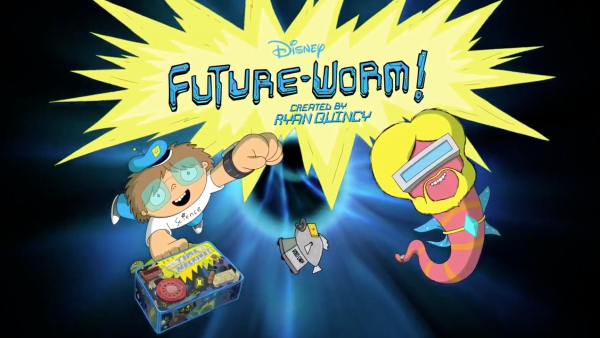
By the time you hear Justin Roiland’s voice pop up in the third episode of Future-Worm, entitled “Terrible Tuber Trouble,” you can breathe a sigh of relief. There was a sense that this show, based on the weird and stilted interstitials and bumpers that aired between Disney XD shows a few years ago, was a rip-off Rick and Morty, Adult Swim’s wildly entertaining hit show. The intros to both shows are tonally similar, and so is the color palette, but the nonchalant comical approach to surprisingly complex plotting is the real, obvious point of comparison. Both shows contain sarcastic, over-the-top, droll alien creatures, and even the father figure characters of both shows are sad-sack loser types. It smells like intellectual theft. But with Roiland’s squeaky, stammering vocals added to the mix, you at least get the sense that the co-creator of Rick and Morty is in on the heist.
Let’s back up a bit. Having low expectations for Future-Worm is understandable. It looks like one of the many secondary shows that attempt to thrive on attention and (young) viewership through weirdness. Such a style was born in the cultural misunderstandings of Spongebob and the genuine understandings of Adult Swim. From Pig, Goat, Banana, Cricket to Pickle and Peanut, to Teen Titans Go, kids networks’ have attempted to create their own “super-weird, super-funny” animated hit, mostly to no avail (except Teen Titans Go, which is still a hit but feels increasingly irrelevant). Future-Worm stars a boy named Danny, voiced by Andy Milonakis (who is in his 40s), who is friends with an anthropomorphic worm named Future (voiced by James Adomian). The show, despite its weird set up and design, has the two run off on adventures across time and space and dimensions, mostly on a whim. This sounds like a generic kid adventure story. Yet there’s an off-handed, devil-may-care approach to their adventuring: the two tend to chart off when bored, or callously looking for dumb answers to dumb questions, or wanting to escape from basic chores. And now the heightened mundane purpose of their travels feels somewhat stolen from Rick and Morty’s various shrugged-off travels.
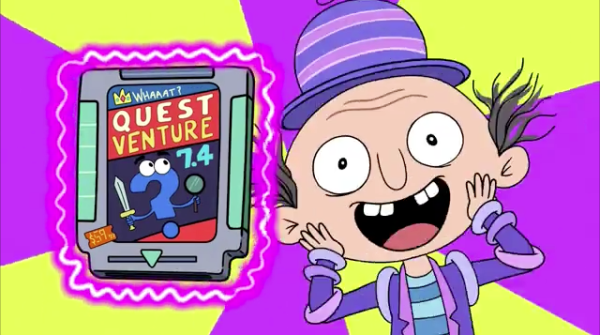
Well, if you’re going to steal, you might as well steal from the best, right? Rick and Morty is one of best shows ever, and with Roiland’s implicit approval of the show, Future-Worm is in good company. But even still, Ryan Quincy and his team manage to guide its influences and channel it through its own voice and direction, creating something that’s unique and weird, but also viciously clever – and viciously complex. From its interstitial beginnings, each episode of Future-Worm is divided into three parts, each of different lengths – twelve minutes, seven minutes, and three minutes. (The various lengths are familiar to animation fans: each type has been used before throughout animation history.) Disney probably mandated the lengths to shore up its burgeoning online/digital shorts package – the network most likely envisioned the show as simply-produced content to toss onto their Youtube channel or their Disney XD app (Disney feels like the only network that takes its online viewership seriously, as it now airs new episodes of shows online the same day those episodes are to be aired on television).
Quincy had something else in mind. Inspired by the post-credits tags in Rick and Morty, which play a comical, fast-and-loose response or commentary on the full episode itself, the Future-Worm team uses its unique structure to play around with the format and with the full marrative timeline of the show itself, while also using it a response or commentary to what came before it – or after it. It’s… difficult to describe, so it’s best to give examples. In the 12th episode, the first part ends with a weird gag in which an errant dimension-traveling device hits Danny’s parents in the head, transforming said heads into a car door and another head entirely. It seems like a random ending. But the second part tells the full adventure of what actually happened to the heads of Danny’s parents, which were transported to a “Death Race” in 3939. Or take the 11th episode: the second part tells a crazy story that Future-Danny (a figure separate from Danny himself) goes on, which involves people made of pliers trying to kill him. He escapes, fortunately, and the third part is Future-Danny trying to convince Bug, a friend of Danny, not to touch a certain pair of pliers, lest those same plier people track him down again. If that sounds confusing, it’s meant to be, but it’s also part of the value in rewatching episodes and tracking, even tangentially, the various timelines of what’s going on. Episodes connect in insanely temporal and atemporal ways, similar to Pulp Fiction’s nonlinear narrative; watch enough episodes, and it becomes clear that seemingly random segments are actually clues to its place within the “Future-Worm” timeline. Even then, the tone and energy of the show is so comedic and so devil-may-care (even the main characters don’t give a crap), that following along isn’t even that big of a deal (but valued if you do). There’s a whole semi-serious subplot involving lizard-people, powerful gems, and a prophesy, but Danny and Future-Worm can barely be bothered with it, even though it seems to be having some far reaching implications.
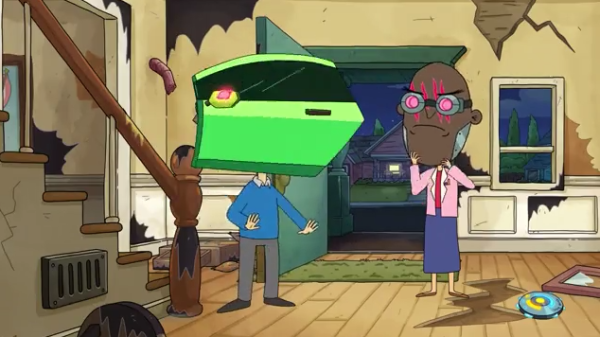
From part 1 of Episode 12, “Bug Vs. the Babysitter”
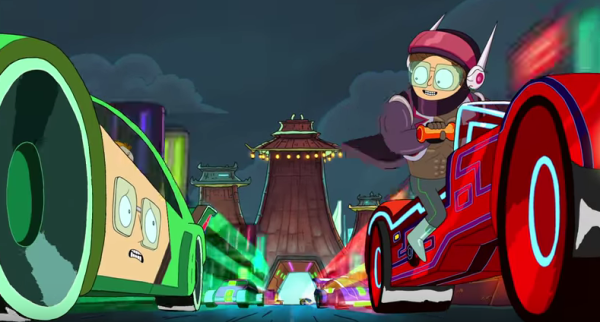
From part 2, Episode 12, “Doug Race: 3939”
Future-Worm is a complex, detailed, interlocking set of stories that combine into a slick, fully realized arc. Yet it also a silly, fun, episodic tale of two characters – a brilliant but lazy kid and a universe-travelled worm within a midlife crisis – who care little about that arc, and quite imply that viewers shouldn’t care either. Future-Worm is essentially a Croenburgean hybrid, a Rick and Morty clone spliced heavily with Venture Brothers’ detailed, go-for-broke, referential world-building, and Phineas and Ferb’s comically clever, winking, substantial fan service. Its slick, multi-layered narrative play is bolstered by animation leagues above its original interstitial visuals (courtesy of the ever-reliable Titmouse Animation) and a keen sense of narrative proportions within its three-part, sectioned structure. Yet unlike Rick and Morty, which approaches its narrative subversions or deconstructions from a world-weary, eye-rolling perspective (as if these well-worn tropes were such a burden to work, a notion that caught up with it in its wobbly, if still entertaining, second season), Future-Worm maintains a certain, idealized giddiness at such narrative opportunity. Future-Worm loves its storytelling, and loves making fun of its own storytelling, both engaging with and subverting it at the same time.
I’m somewhat reminded of The Aquabats Super Show, a short-lived show starting the infamously fun ska band that brilliantly, yet silently, “looped” its first season by connecting the final episode with the animated segments in its first episode, and connected the animated segment in the final episode with the live action of the first one. As I wrote about that show year ago, Future-Worm, in some ways, updates that premise. It doesn’t simply connect episodes, but interconnects them, while subverting them, deconstructing them, ridiculing them… and yet still can produce a sharp, tense episode of high stakes and nail-biting action. Watching Danny and Future-Worm battle it out with the Time Travel Council is funny but formidable, similar to how Rick and Morty faced the Council of Ricks in “Close Rick-counters of the Rick Kind.” And the similarities can not be ignored. But it’s the culmination of stories told and yet not told, of characters seen and not yet scene, of interlocking arcs that were experienced and soon will be experienced.
Or not. I mean, Amelia Earhart is there.
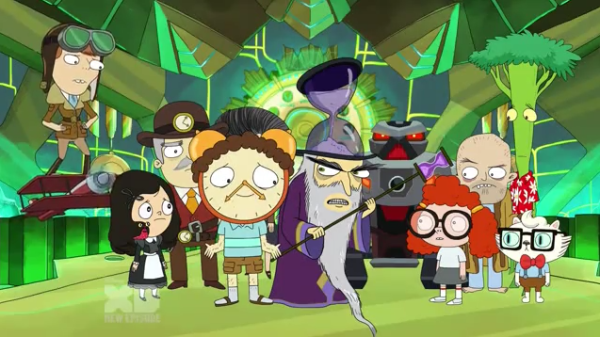
Stories are funny that way. So is time. So are the way we tell and consume stories these days. Future-Worm knows this, and uses it to its advantage.
Star Vs. The Forces of Weirdness
Posted by Admin in Animation, Television, Uncategorized, Writing on July 6, 2017
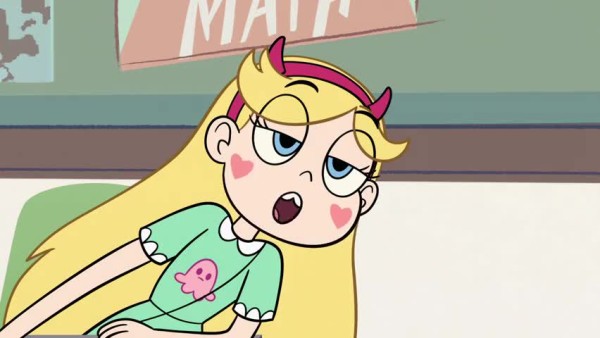
There’s an episode in the second season of Star Vs. The Forces of Evil called “Trickstar.” Weird Al Yankovic voices a creepy magician named Preston Change-O, who is invited to the birthday party of Marco’s sensei (at this point in the series, Marco and his sensei are friends for some reason. I’ll get into this in a bit.) Star, she of the magical propensity from the alternate world of Mewni, vaguely recognizes Preston and begins to suspect that something is off about him. Indeed, when Preston performs a magic trick, and his audience cheers, Preston sucks up the energy from their enthusiasm. He literally sucks in their “joy,” and his hat grows longer. It’s kind of a ridiculous visual. Anyway, Star recognizes this danger and tries to warn everyone, but those around her deem her a spoilsport – someone who’s trying to steal all the attention from the sensei’s festivities. Ironically, the episode does purport that Preston’s joy-stealing is, at worst, just a small annoyance: no one is deeply affected when their joy is snatched, and Star’s obsession does make her seem overzealous (the episode never quite expounds on what exactly this “joy” is, undercutting the plot; I’ll get into that deconstruction later). Well, no one is affected but Jeremy, whose joy seems like it’s completely gone, and is left sitting on the sidewalk as an ultra-depressed husk. The show posits Jeremy as kind of a joyless loser, but not the kind whose captured happiness seems warranted. Jeremy is all but rendered useless, but other than that “Trickstar” tries to be clever and undercut a common animation plot trope (with… another plot trope?). It doesn’t quite work.
Star Vs. The Forces of Evil has had a hell of a second season. The first one was a fun, wacky romp of adventures and insanity, with a John K. sensibility that overcame the weaknesses of some of the characterizations (most notably in Marco’s friends, who are rarely seen in the second season). The show’s sophomore run toned down the abject silliness a lot, opting for something a vibe that is split between Steven Universe and Adventure Time; the aesthetics are more grounded, measured, and methodical. It’s a pretty notable shift, and it’s a shift that’s not just regulated to the animation. The characters are more… well, I don’t want to say mature, but they are more distinct, more complex in a way that suggests the writers are pursuing long term development for its cast. What makes that stand out, however, is in order to do that, Star Vs. has decided to travel down some insanely odd, unusual, unconventional narrative paths to get there.
I think about that “Trickstar” episode a lot; it’s such a good example of what the show seems to be trying to do, and yet, stumbles on at times. I think the idea of subverting the narrative trope of a figure who sucks some kind of “essence” from people is worthy of doing, but I question the end result when, essentially, one character is effectively destroyed by it, and the weird, tonally off, ambivalent/ambiguous/indifferent theme of the entire episode (let’s be clear: Preston is stealing something from people, and whether or not it’s “harmless” is besides the point – it never was his to take). Star Vs. is clearly eager to subvert and/or deconstruct the kinds of episodes we have come to expect in our animated series. I don’t think it does a great job; or, more accurately, I don’t think it has quite a handle on the full extent on the narratives it tries to subvert or deconstruct (certainly not to the extent that Gumball does, which understand its tropes in minute detail so that its subversions/deconstructions work beautifully).
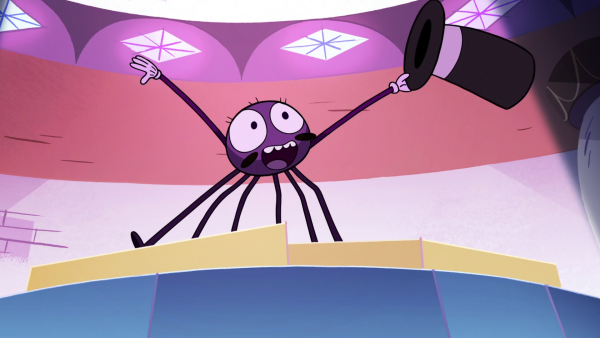
Take “Spider with a Top Hat,” a wildly off-beat episode in which we explore the lives of the very strange, whimsical animals that zap forth from Star’s wand. The creatures spend their lives within Star’s wand like a TARDIS, prepping their existence in order to do battle when summoned; a hapless, cheerful spider at the center plays the role of moral support for these magical warriors. The spider is also pining for his chance to be summoned into battle as well, even though he can barely break a wall with his head. This…. all works better in context, its baffling premise making more sense on the animated screen. It’s a narrative that’s certainly unexpected, but waddles into laziness when the spider, upon being summoned in desperation during a viciously tense battle, suddenly deploys a gattling gun from underneath his top hat. It’s a sudden, throwaway climax to a unique story with a unique premise: the kind of answer you’d find in a notebook of a eight grade boy. “He had a BADASS gun inside him all along” is flat storytelling.
That’s the kind of episode development that hints at Star Vs.’s core issue. It’s second season truly seeks to tell very unique, very audacious stories, but in many ways struggle to push that desire into something meaningful or perceptive. All of the crazy, wild narrative beats and questionable characters are put in place to throw audience expectations askew, but it’s clear that’s just all the writers want to do. The main thematic thrust is about insecurity, mainly centered around a jealousy Star develops when Marco and Jackie (a typical bland, “chill” female character) begin a relationship. Insecurity is part of most, if not all, the episodes of the season, and you can make the raw argument that these off-kilter storylines are meant to instill a level of discomfort and awkwardness in the viewers as well – you’re supposed to feel uncomfortable from the “incompleteness” of an episode, to best reflect the uncomfortableness felt buy all the characters, their relationships, and what they’re all going through.
It’s extremely tough for me to buy, though, as some of the decisions feel less like a bid for thematic resonance, or connections towards insecurity and discomfort, and more just narrative curveballs for the sake of them – both in characterizations and it storytelling choices. For example, Star Vs. opted to lean on an assortment of new characters defined by a “quirk” that’s less “pixie” and more “disturbing”. The first episode introduces a women who collects hair; when she admits this, there’s a music cue that indicates danger. But she’s anything but: she in fact helps Star through her predicament. Which is fine, within the broad, generic lesson of not judging books by their covers. The overall impact of her appearance is moot, though: other than a reference to this woman and her weird hobby later in the season, she feels like a waste of a unique character. Other weird characters include a dog suffering with depression, a insecure being with talking snakes for arms (who gets in way over his head), and a former Mewni warrior turned homeless-sociopath on Earth. Each character is unmistakably distinct, but they never leave a lasting impression. What purpose do they serve, particularly in a season clearly working its way towards a bigger, grander arc? Even recurring characters feel formless. I somewhat can abide by Tom and his anger issues, but he functions better as a toxic, masculine obstacle to Star than jerky man-friend to Marco. I can’t say the same for Marco’s sensei, whose friendship makes less sense than Marco’s original first season friends – at least they were in the same grade as him. Marco’s sensei is a pathetic manbaby who more or less guilts Marco into befriending him, which in and of itself is a pretty toxic event.
And sometimes, I think the show misunderstands the difference between insecurity and personal secrets. “Naysayer” involves a curse that’s supposed to get Marco to admit his deepest secrets, but the episode ties them to his insecurity, and fails to realize they’re completely different. Nervousness in asking a girl out – and the hundreds of reasons that one conjures up that would prevent said girl from returning the affection – is the key to Marco’s insecurity. “Naysayer” forces Marco to just say a bunch of weird personal stuff that he does. I get that the show is trying to tie those personal behaviors to his fear of asking Jackie out, but since we’re not clear on what specifically about himself and those behaviors that worries him in relation to Jackie, it comes off completely the opposite of what the scene probably intended. (You try telling someone you barely know all the weird shit that you do out of the blue.) But since Jackie is barely a character, she’s totally cool with it all.
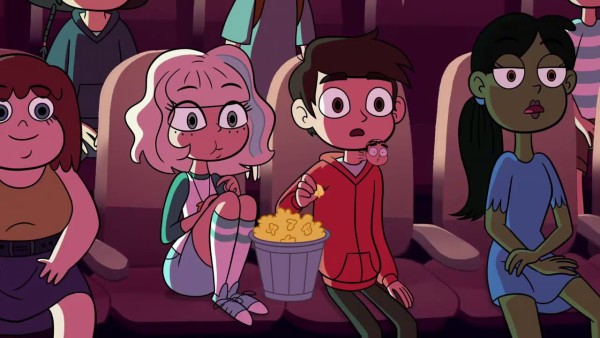
This is, in some ways, a manifestation of an issue that bogged down the first season: Marco receives quite a bit of screen time for a show ostensibly titled Star Vs. the Forces of Evil. And it’s not as if Marco is a bad character. He’s clearly an important one as well. But Star’s conflict, whose personal sensibilities and attitudes butt up against Mewni’s expectations and historical legacies, is a juicier, meatier narrative than anything to do with Marco. While I admire the second season’s attempt to blend her conflict with the emotional struggle Star is going through upon learning of Marco and Jackie’s romance, it still remains at odds. It feels like a narrative step back from the lesson she learned in “Sleepover,” where crushes and desires ebb and flow overtime, but it also feels like a secondary conflict forced to the surface over the more intriguing narrative of the bizarre Mewni situation involved Ludo, Bullfrog, the return of Toffee, Glosseryk, and Star’s own mother. Also, to be blunt, the narrative building of this conflict comes off incomplete, a smorgasbord of mediocre, world-building, wheel-spinning that, to me, signifies a backstory that’s still being worked on. Nothing that occurred this season seems meaningful, important, or intriguing enough to follow. The reveal in first season’s “Mewnipendence Day” – that Mewni was most likely the aggressive force that subsumed the more innocent, native monsters – feels more worthwhile than the vague information that dripped out during the course of the season.
Looking back over that second season, eyeing episode descriptions while re-watching select ones, I admit that despite my criticisms, my curiosity is still piqued. Yet it’s not for a real desire to learn the secrets and truths of the world and history of this Mewni/Earth setting (and the characters that inhabit it), but more for the sake of relief – an assurance that the creative team does, in fact, have a real long-term arc ahead of them. I’ll swallow up Star’s personal feelings and heartache if that struggle is dealt with in strong collaboration with the greater conflicts and reveals that will emerge from what Ludo, Toffee, Glosseryk, and the entire Butterfly family holds. What do we know at this point, in terms of the overall story? We learn that Star is extremely powerful, which would have been better served to learn as we see Star’s power grow (we don’t really see this). We learn someone is “draining all the magic” in “Page Turner,” which is just a nebulous statement – why should be concerned about this? And by the season finale, we learn that Toffee is back, which is cool (Toffee was one of season one’s greatest characters), but we don’t know what this means.
And yet, I don’t think that the second season of Star Vs. is bad, per se. A lot of it is great, and interesting, and just weird enough to keep paying attention to, and it’s worth at the very least talking about, way more than any potential Marco/Star ships. I do think that, in its desire to be part of the pantheon of great cartoons like Gravity Falls, Gumball, Adventure Time, and Steven Universe, it sought depth and irony and deconstruction and subversions, but it all amounts to blank slates and purposely confusing oddities; its weirdness is the animated version of what Matthew Christman describes as (animated) TV becoming respectable without getting better. For all it’s faults, I do respect the hell out of Star Vs. The Forces of Evil, and maybe its third season premiere will tie this all together in some significant way. But it’s desire to be a game-changer makes the entire season seem like work: I can feel the effort and strain behind it to be “talked about.” What I don’t feel is the one thing that Star herself would want to be: fun.

